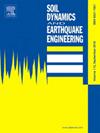Seismic risk transfer in multi-span simply supported beam bridges for high-speed railways
IF 4.2
2区 工程技术
Q1 ENGINEERING, GEOLOGICAL
引用次数: 0
Abstract
This study introduces an innovative method for seismic risk transfer in multi-span simply supported beam bridges used in high-speed railways. By integrating seismic risk transfer devices within bridge segments, the seismic risk is efficiently redirected to subgrade segments, thereby mitigating the seismic response of the bridge structure. Finite element models were created using OpenSees, and nonlinear time history analyses were performed with 40 sets of ground motion records to assess the impact of the seismic risk transfer system on both bridge and track structures. The study also examined the influence of the stiffness and yield displacement of the risk transfer devices on their effectiveness. Furthermore, a seismic response and damage assessment method based on hypothesis testing was proposed. This method was utilized to calculate and discuss the impact factors of the seismic risk transfer system for various pier heights and span numbers, and to evaluate its effect on the seismic damage risk of critical components. The findings demonstrate that the seismic risk transfer system can significantly reduce the variability in seismic responses across different spans, thereby enhancing overall seismic performance. The system transfers the seismic response of mid-span structures to side spans and subgrade segments, facilitating post-earthquake repairs and improving the overall economic efficiency of the bridge structure. This research provides new insights into the seismic design of high-speed railway multi-span simply supported beam bridges and holds significant implications for post-earthquake repair cost control.
高速铁路多跨简支梁桥的地震风险转移
本研究介绍了一种用于高速铁路多跨简支梁桥地震风险转移的创新方法。通过在桥段内集成地震风险转移装置,可有效地将地震风险转移到路基段,从而减轻桥梁结构的地震响应。研究人员使用 OpenSees 创建了有限元模型,并利用 40 组地面运动记录进行了非线性时间历程分析,以评估地震风险转移系统对桥梁和轨道结构的影响。研究还考察了风险转移装置的刚度和屈服位移对其有效性的影响。此外,还提出了一种基于假设检验的地震响应和损坏评估方法。利用该方法计算并讨论了不同墩高和跨度数下地震风险转移系统的影响因素,并评估了其对关键部件地震破坏风险的影响。研究结果表明,地震风险转移系统可显著降低不同跨度地震反应的变异性,从而提高整体抗震性能。该系统可将中跨结构的地震反应转移到边跨和底层区段,便于震后维修,提高桥梁结构的整体经济效益。这项研究为高速铁路多跨简支梁桥的抗震设计提供了新的见解,对震后维修成本控制具有重要意义。
本文章由计算机程序翻译,如有差异,请以英文原文为准。
求助全文
约1分钟内获得全文
求助全文
来源期刊

Soil Dynamics and Earthquake Engineering
工程技术-地球科学综合
CiteScore
7.50
自引率
15.00%
发文量
446
审稿时长
8 months
期刊介绍:
The journal aims to encourage and enhance the role of mechanics and other disciplines as they relate to earthquake engineering by providing opportunities for the publication of the work of applied mathematicians, engineers and other applied scientists involved in solving problems closely related to the field of earthquake engineering and geotechnical earthquake engineering.
Emphasis is placed on new concepts and techniques, but case histories will also be published if they enhance the presentation and understanding of new technical concepts.
 求助内容:
求助内容: 应助结果提醒方式:
应助结果提醒方式:


